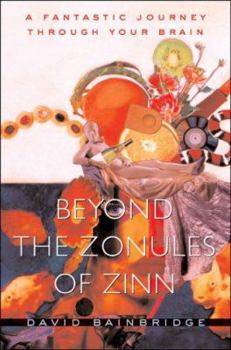Beyond the Zonules of Zinn: A Fantastic Journey Through Your Brain
Select Format
Select Condition 
Book Overview
The accessible approach of this book lays out what is known about the brain (its structure), what we can hope to know (its function), and what we may never know (its evolution).
Format:Hardcover
Language:English
ISBN:0674026101
ISBN13:9780674026100
Release Date:February 2008
Publisher:Harvard University Press
Length:338 Pages
Weight:1.46 lbs.
Dimensions:1.1" x 6.5" x 9.4"
Customer Reviews
3 ratings
If you want to learn about the human brain ....
Published by Thriftbooks.com User , 14 years ago
This book was recommended on a podcast called "Brain Science" that discusses aspects of human brain physiology and function. You might expect this to be a dense, technical book but it is not -- it is very accessible while still being packed with interesting info on the brain (human and related mammals). If you are interested in this subject, this is a great book to get started with.
Irresistible
Published by Thriftbooks.com User , 16 years ago
When I came across 'Beyond the Zonules of Zinn' by David Bainbridge, memories of Harlan Ellison's SF story 'Adrift Off the Islets of Langerhans' had me searching for more details. Now, as most of you likely know, the Islets of Langerhans are where the hormone producing cells of the pancreas are grouped. The details of the Bainbridge book indicated that the Zonules, like the Islets, were an anatomical structure, but that the book was, unlike the Islets, fact not fiction and dealt with the central nervous system and the brain. It was structured as a trip - an exceedingly fantastic voyage - up the spinal cord and into the brain, discussing the extraordinary features which occur seemingly at every millimeter along the way. Now I am not only an SF fan (so that the very title of Bainbridge's book made purchasing it inescapable) but I occasionally - well, actually, only too frequently - buy books based on their cover, and this cover pledged a journey into surrealistic realms. Snakes, booze, Odalisques (that is, sex), food, flowers, music...all seemed inevitable companions on the pilgrimage. But, yet again, I find books about the structure and the working of the brain and the mind virtually irresistible, and have done so since my first year at university, 54 years ago, when I discovered the Medical Library (yes, I'm really that old a fart). I had to buy the book. And I am penning this short article because it not only lived up to expectations, but surpassed them in terms of wit, humour, graceful writing, and, above all, interest and knowledge. I urge all who are inquisitive readers, to buy the book. For those, who like me on reading the words Zonules of Zinn, want to know just what they are, it is that they are features of the eye. The lens of the eye is focussed by a muscular ciliary which acts to flatten the lens by connections between the muscle and the lens. These connections are the `many minuscule fibers...tiny tendrils, the most delicate part of the brain' called the Zonules of Zinn. And if you're worried about that last statement - `the most delicate parts of the brain' being within the eye - well, that's not an error. Bainbridge points out that the eyeball, in a fetus, is initially a plaque on the skin of the embryo to which part of the brain is attracted. This stalk turns into a cup which almost surrounds the eye plaque, and then closes off the sequestration with the cornea. But the interior of the eye - the retina - and the optic nerve (or tract) are one, and part of the brain. As Bainbridge says: "So when you gaze lovingly into somebody's eyes, you are actually staring at the perforated frontmost extension of his or her brain... Yes, the iris is the brain - the window on the soul after all...and it is the only part of the brain which can move itself". Which I think is pretty fantastic. But there is much, much more in the book. You will learn about other SF landscape features, such as The Island of Reil, The Islands of Calleja, Galen's
wonderfully accessible
Published by Thriftbooks.com User , 16 years ago
A wonderfully accessible book of brain function and structure. I have no idea how "accurate" it is from a scientific perspective, but I found it easy to follow and fun to read. Bainbridge appears to put forward the accepted current "knowledge" of the brain while simultaneously raising some of the more contested questions for readers to ponder. He briefly addresses the contentious issue of consciousness, in a very measured way, providing seven potential explanations. The book proceeds through a "geographical" tour of the brain on the premise that the brain's function can be (somewhat)explained by where in the brain the particular anatomical feature is. He starts with the brainstem and moves forward to culminate with the cortex. While he suggests that location can help us understand function, he carefully points out where this theory does not hold up. If I understand his "conclusions" accurately, current brain research suggests that it is the pattern of connections in the brain (and more specifically the association cortex) that determines how the brain functions. So, while some of the simplistic views we've all been taught about right and left brain differences and lower and higher order brain functioning is (somewhat) valid, but ultimately the brain is much more complex than that. What I would have really liked is a metaphor that could capture this perspective. My memory isn't that good. Bainbridge does touch on memory and emotion, but as any good scientist probably would do, he does not draw many conclusions in this area because of how difficult it is to "know" exactly what's going on in these areas.






